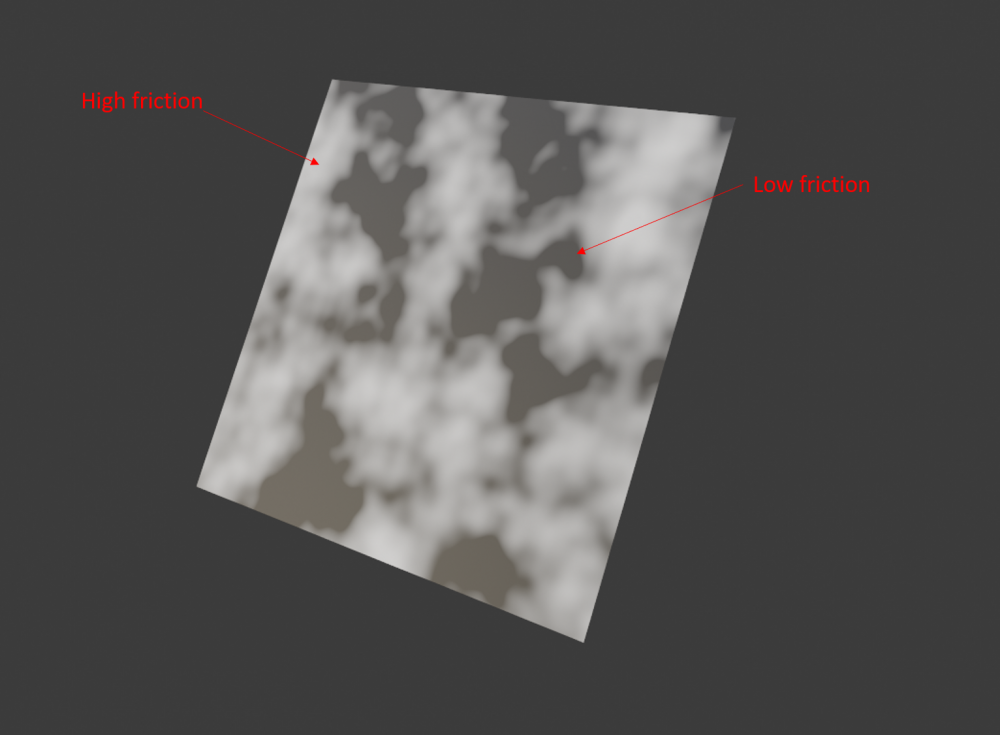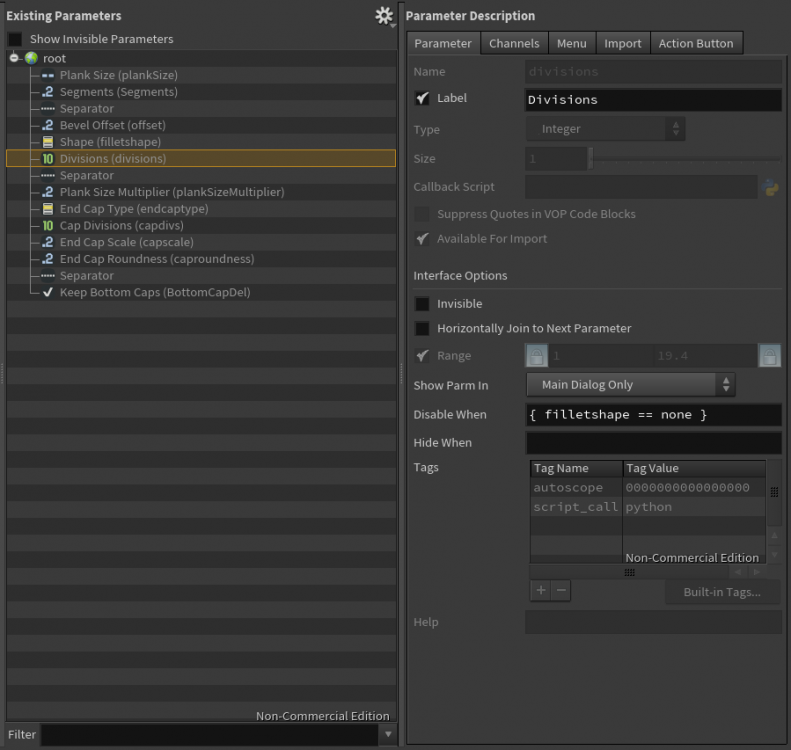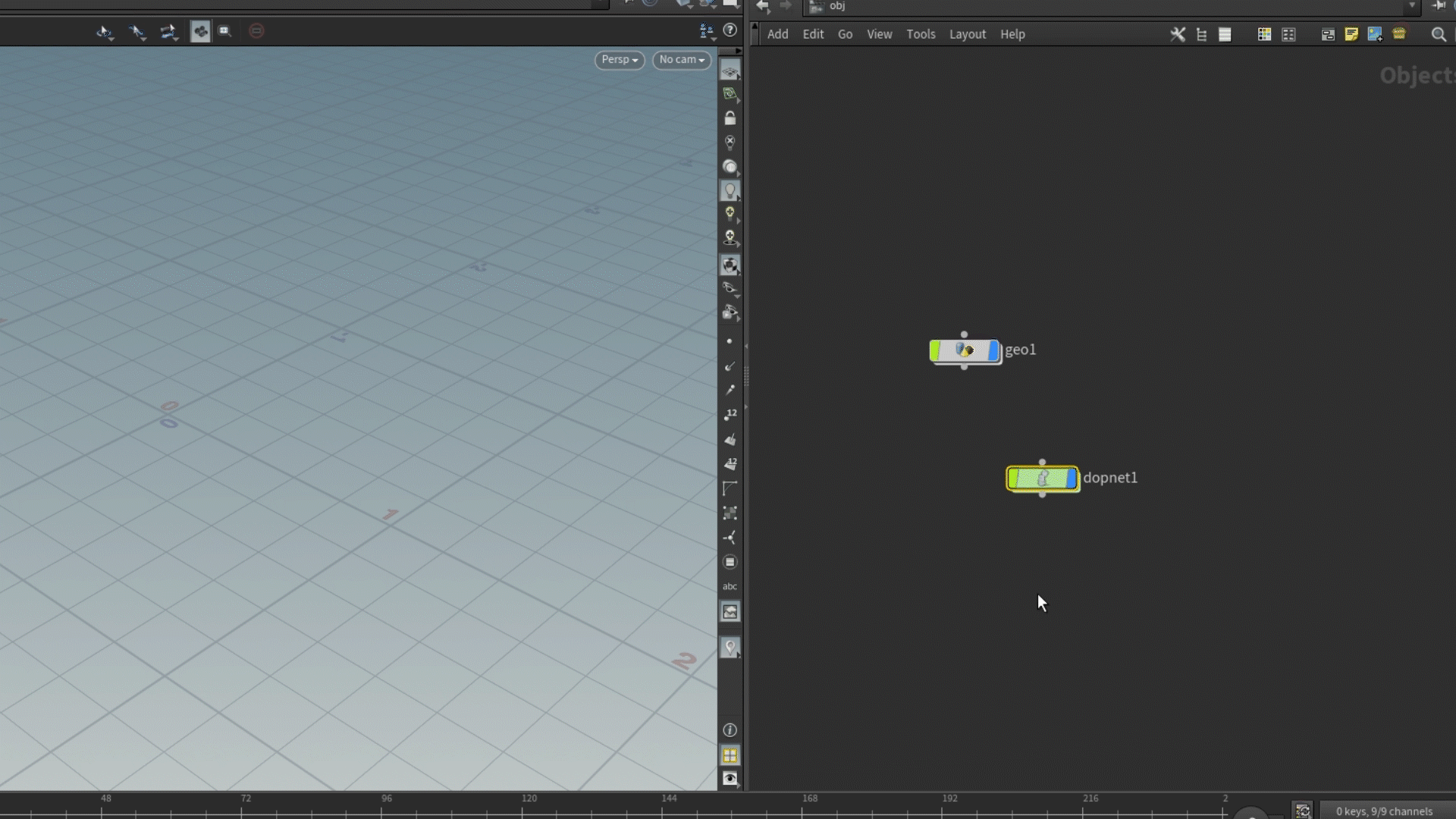Search the Community
Showing results for tags 'parameters'.
-
Hi, I would like to know how to achieve and animate something like this in the first video https://www.behance.net/gallery/175765483/LOEHR-x-Spot-Studio? (Screenshot of what I am talking about below) In regard to 1/ which grain properties to adjust 2/ How to achieve clustering some grains as you can see on top - are these separate vellum grain objects set to different seperation rates? 3/ Would be nice to know how you guys go on about optimizing your grain sims.. I run an 12core i9 and it is struggling even with 200K points Much appreciated.
- 1 reply
-
- motion
- optimization
-
(and 4 more)
Tagged with:
-
Hi there, I'm still a newbie in Houdini but I realy enjoy learning it! Now I have a question which realy can make my life easier. Is there a way I can find the attribute name of specific node parameter easily? For example: I have a mountain SOP and wanted to change the "height" parameter via an attribute wrangle. I know that I can access this one by using @height in a wrangle, which I found via a google search. But is there a way I can find this out in Houdini itself? This would save me a lot of time. I hope I'm clear in my question.
- 4 replies
-
- 1
-

-
- vex
- attributes
-
(and 1 more)
Tagged with:
-
Hi ! I'm making a digital asset where I want a parameter to disable itself if the opinput 1 is wired to something (just like the Box SOP that disable the size parameter when connected to a geometry). Do you know a way to do so ? NB: I saw that there was already a topic about it, but it is very old and a lot of fields they're talking about doesn't exist anymore. Thanks for your replies !
-
I'm trying to build a list of all the parameters of a certain type from a node in python. For instance for a geo node, I want to build a list of all the toggle parameters on it. Comparing hou.node('/obj/geo1').asCode() and hou.node('/obj/geo1').parms() was going down a very messy road. I was hoping there was a way to use just the .parms() and check if each parameter is a toggle type? *Edit I feel like this may have something to do with it, https://www.sidefx.com/docs/houdini15.5/hom/hou/ToggleParmTemplate However only when I add a spare parameter and run .asCode() does it seem to reference this, and I can compare against .parms(), but it doesn't work on regular parameters.
-
I'm currently building a POP network to simulate rain on a window and would like to mimick the small variations in surface tension that help cause the erratic motion of rain drops running down the surface. I know how to do vary an attribute using VEX, but I'm not sure how to go about it with parameters, since I can only assign one friction value for the whole of the geometry in the Static Object SOP. Any help would be great!
-
version 18.0.287, 18.5.462 I am trying this manually (right click on parameter name >> lock parameter) and using python hou.geometry.SetHardLocked(True) but nothing is working on this. In addition, it will crash if I try to change that parameter after lock. Any other choices or reason why this doesn't work?
-
Hello, I am creating an digital asset for a personal project that I am working on. As soon as I saved the digital asset, all the parameters are locked and I cannot change it. Can someone please tell me how to edit those parameters? I have attached a screenshot of edit parameter interface, in parameter description, you can see all of the fields are locked except for a few. Thanks for your help
-
I've been told how to create a primitive in a previous post. Creating a primitive - General Houdini Questions - od|forum (odforce.net) Now I want to know if I can set up custom parameters for my primitive? I want it to have similar parameters that the scales in the video below have. 08_RepTile_Scale_Test_01_InitialTest.mp4
-
Hi everyone, Short explanation: I want to be able to see parameters (of a Houdini Digital Asset) that I created in Houdini’s Python Module, in Unreal. Long explanation: I’m creating a Digital Asset in Houdini and want to use it in Unreal. When I create parameters in Houdini in the “Type Properties” window everything is fine and the asset works in Unreal and parameters are visible and can be adjusted. Now I added some a Python function in the Python Module of Houdini that creates some parameters. I also created a button that when pressed, triggers this function. This all works in Houdini but as soon as I export this to Unreal the button does nothing. If I use the Sync Session in Unreal (so I have my Houdini and Unreal open at the same time with the same asset) and press on the button (in Unreal), then the parameters do get created in Houdini, but still not in Unreal. The only solution I found so far is, place the tool in Unreal, go back to Houdini’s “Type Properties” window, save the tool again and press “Revert Layout” in the pop-up window. Only then the parameters created in Python get visible in Unreal. But as soon as I place another HDA in the level I have to do that all over again. I want the user to use this tool only in Unreal, without reverting the layout all the time in Houdini. Is there away to achieve this? Thanks in advance, you would really help me out here!
-
- houdini
- unreal engine
-
(and 5 more)
Tagged with:
-
Hello, guys! For example, I have a button with a callback function and some float value: PRM_Template(PRM_CALLBACK, 1, &someBtnName, 0, 0, 0, &callbackFunc), PRM_Template(PRM_FLT, TOOL_PARM, 1, &someValueName, PRMzeroDefaults), ... int callbackFunc(void *data, int index, fpreal t, const PRM_Template *tplate) { ... } How to change value of a float control from the callbackFunc function?
-
Hello guys, I'm new to Houdini and to writing python scripts for Houdini. I'm currently working on a project where I want to change the Rotation, Scale or Transformation of a geometry node by moving physical rotary encoders, which are connected to an Arduino Uno. The serial connection between Houdini and the Arduino works fine. In my script, which I save as a custom shelf tool, I change the parameters of the node by using the set() function of the Parm object. The amount of change comes from the encoders. For example: node.parm('tx').set(change) The problem for me is that while the script is running and I change, for example, the rotation of a cube, like node.parm('rx').set(25), the cube is not rotating in the viewport. The cube is only changing once the script has finished and stopped running. Basically, the viewport is only updated with the new, for example, rotation parameters once the script has finished running. The geometry node is not moving in the viewport while the script is running. My goal would have been to have the script running in the background while working on Houdini like usual, and when changing the rotation of a node via set(), the node is also rotating in the viewport. Therefore, my main question: Is there a way with the hou object to force the viewport to display all the currently new set parameters of a node (like Scale, Rotation and Transformation) while a python script from the shelf is running. Thank you for your help.
-
Hello, I am having trouble randomizing parameters from instanced geometry from within an "instance" subnet. Say for example I wanted to randomize the speed of an instance's animation (on the sop "timeWarp" node), or the start frame of the instance's animation (on the sop "timeShift" node), or perhaps randomize it's material. Please check attached file. Thanks in advanced. instance_randomize.hiplc
-
Hello Houdini Users, I am new around the forum, and have been exploring the software for some time now. I come from a Realflow background, where I usually would go for an open domain Hybrido simulation and the particles could leave the container freely. Now confronted with the FLIP Tank workflow, I realized that the waterline option kills the particles at the boundary, instead of them rebounding (I always get some rebound with just waterline turned on), making it look like the container's walls don't exist above that certain waterline level. To avoid the loss of volume due to the killing of the particles,I turn the boundary layer on and it looks like it somehow replenishes the particles, but it generates artifacts that I can't comprehend: -Just turning on the boundary layer and leaving the padding at 0 makes it look like it is not working at all, thus I still loose volume and get some rebounds. -If i set padding values like for ex. 1 (in x and z) I get jittery particles around the boundarys. Could some one explain to me how is the Boundary Layer suppose to work (very briefly), most specificly the "Padding" options and in what context should it be used? Thanks, Diogo
-
Hey guys and girls I'm very new to python and Houdini tool creation.This might turn out to be incredibly simple for you,I have a button that when click dives into my current digital asset my objective is to before diving to pin/lock/focuses the parameter pane that I clicked the button on(so the current node).I cant figure out how to use the classes Desktop,Pane,PantTab to do this to save my life. Am I simply approaching the problem wrong?I would greatly appreciate any help on this, Thanks in advance.Cheers!
-
Hey. I have a problem with overwriting values from wire object in SOP Solver. If klinear parameter (Linear Spring Constant) is set to 300 in wire object and then I'm writing inside sopsolver in point wrangle @klinear = 300; just for test, then my simulation looks different, less stabile (?). Why is that happening? This is the same value so it should be the same sim. I was trying to put sopsolver before and after the wire solver and there was the same situation.
-
Hi Everyone, We're having a major problem at work. A couple of our artists have OBJ-level digital assets that they've created, with lots of custom parameters. These digital assets are installed in their current hip files. When we use the Operator Type Manager to copy or duplicate the asset to another directory/version up, the new asset loses all its custom parameters, even after using Save Node Type and Match Current Definition. We've tried everything we can think of, but once we try to copy or duplicate the asset, all the parameters get deleted. Has anyone else run into this? And what's the solution? Thanks, ~Chris
- 4 replies
-
- hda
- digital assets
-
(and 2 more)
Tagged with:
-
when I link some parameters some of the main node get crazy wire messing up the node. example Node A has some parameters link between them. example nodeA.parm("bla") and nodeA.parm("ble") is set as reference link to nodeA.parm("bla") nothing crazy one parameter looking at another one in the same node. now I want to create a new node and link all the parameters to this new node I want nodeB parameters to look at nodeA, after running the code witch is a regular stuff just setting parameters, some of the paramters in nodeA that were just a integer now have an expression poiting to another parameter =( should I create something like if its an expression use "setExpression" if is not an expression use the regular set? def linkParmsTo(source_node, target_node): """ Link the parms of the source node to those of the target node if a parameter with the same name exists. # Produced by: # Graham Thompson # captainhammy@gmail.com # www.captainhammy.com """ for parm_to_link in source_node.parms(): # Skip folder parms. if isinstance(parm_to_link.parmTemplate(), hou.FolderSetParmTemplate): continue parm_to_link_to = target_node.parm(parm_to_link.name()) # If the target parm exists if parm_to_link_to is not None: parm_to_link.set(parm_to_link_to)
-
- parameters
- python
-
(and 2 more)
Tagged with:
-
Hi I want to ask a simple question, how to unscope parameter that is scoped using the shift + LMB shortcut? I can't unscope by clicking elsewhere, I figured out if I click other object in the network it will scope that object, then I can deselect by clicking elsewhere. So is there any other way?
-
Hey! I'm trying to add the pyro shader image planes (fire_color,fire_mask,smoke_color,smoke_mask) to the list of check box image planes introduced in H14 to quickly turn them on when I'm rendering pyro stuff. Just copying the ones that are already there in the parameter editor and replacing the image plane names with those ones didn't work, though. Does anyone know if it's possible to edit the Mantra node in this way? Thanks!
-
Hello, guys. While developing some complex operators in HDK I realized that defining lots of parameters becomes a bit tedious and routine task. So I decided to simplify this using C++ templates, and that's what I want to share. All you need is to define these parameters inside newSopOperator() function. Here's how it looks like: void newSopOperator(OP_OperatorTable *table) { PRM_LIST_START(myTemplateList); PRM_FLT(flt, "FLT", 0.01); PRM_INT(integer, "INT", 3); PRM_TOGGLE(toggle, "TOGGLE", ON); PRM_STRING(string, "STRING", "Hello, World!"); PRM_FLT2(flt2, "FLT2", 0.01, 0.02); PRM_FLT3(flt3, "FLT3", 0.01, 0.02, 0.03); PRM_XYZ(xyz, "XYZ", 0.01, 0.02, 0.03); PRM_RGB(rgb, "RGB", 0.3, 0.15, 0.85); PRM_UVW(uvw, "UVW", 1, 0.5, 0); PRM_BUTTON(btn, "Button", callback); PRM_LIST_END(); table->addOperator( new OP_Operator("hdkParmsDemo", "HDK Parms Demo", SOP_HDKParmsDemo::myConstructor, myTemplateList, 0, // Min # of sources 0, // Max # of sources 0) ); } The same easy thing is about reading: // Automatically create variables with parameter names READ_FLT(flt); // double flt; READ_INT(integer); // int integer; READ_TOGGLE(toggle); // bool toggle; READ_STRING(string); // UT_String string; READ_VEC2(flt2); // UT_Vector2 flt2; READ_VEC3(flt3); // UT_Vector3 flt3; Header and sample SOP are attached in the archive. Would appreciate your feedback HDK_Parms.zip
-
Hi. I like to decorate my assets in some common style. Is there a way to generate some default template for digital asset when it's created? For example when I press Create Digital Asset... I would like to have separator/label/separator trio added by default. Can it be done? Thanks!
- 4 replies
-
- default
- parameters
-
(and 2 more)
Tagged with:










